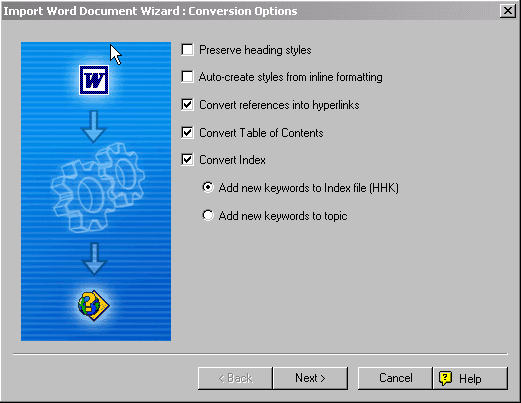Importing Documents and Applying Styles
Importing Documents and Applying Styles
With RoboHelp, you can import many different formats. You have seen how easy it is to import HTML files, but it is just as easy to import DOC and PDF files you create with Microsoft Word, RoboPDF, or Adobe Acrobat. Plus, you can also import XML files.
When you import a Word document into RoboHelp Office, you create new HTML topics based on styles in the Word document. Therefore, every time RoboHelp encounters a certain style in the Word document, such as a particular heading, it creates a new topic and adds it to your project. This is useful because it means that you do not need to make hundreds of separate topics; instead you can create and format your entries in a single Word document that you import into RoboHelp.

Figure 6. The Import Word document wizard
- Select File > Import > Word Document to launch the Import File dialog box.
- Use the dialog box to browse to the Word document, XMLcreateElement.doc, from the ZIP file you downloaded in the Requirements section.
- Select XMLcreateElement.doc.
- Click the Open button to start the Import Word Document Wizard.
- Leave the settings at their default values.
- Click Next to open the Split on Style dialog box. In this step of the Wizard, you to create new topics based on different styles within the file you import.
- Select Heading 1 from the left hand pane.
- Click Finish to complete the Import Word Document Wizard.
After a couple seconds RoboHelp converts the document into topics and displays a Results dialog box. The Results dialog box shows what files were successfully imported into the project.
Before you look at the project, you need to construct a table of contents (TOC) from which your users can easily navigate and browse pages within the project.
- Click the TOC tab in the bottom left corner of RoboHelp. Find the Auto-create TOC button in the TOC tab.
- Click the Auto-create TOC button and a dialog box opens.
- Make sure to select both check boxes, the Delete Current TOC Before Creating New and Create TOC Pages for Mid-topic Links check boxes.
- Click OK to create the table of contents.
That’s it! RoboHelp automatically generates your table of contents. You can drag and drop topics and folders to reorder the table of contents. You’re now ready to compile the project into static HTML files to test and upload the completed project.
The easiest way to compile your project and test the generated pages is to click the Generate Primary Layout button in the toolbar (the icon to the immediate right to the Save All icon, which looks like three diskettes). Click the button to compile and test your project. After a couple seconds of processing, RoboHelp displays a dialog box that informs you RoboHelp successfully built your project files. Click the View Result button at the far left of the dialog and RoboHelp displays the project in a browser window.
Take a minute to test and view the project in the Web browser. You’ll notice that the contents are organized in their respective folders and in the order you specify within RoboHelp. The Index tab doesn’t work yet because there is a separate wizard you need to run before the index is set up. However, you can use the Search tab (or the search box in the top frame) to search through your project’s topics for keywords that you specify. If you click an entry in the search results, it reloads the main frame with the page you select. These are some very impressive results for just a few clicks and a bit of typing.
You might notice that some pages are unstyled and look like they do not belong in the project. This occurs because a style sheet is not linked to the topic, or because the topic is created outside of RoboHelp. Fixing this problem is simple, just follow these steps:
- In RoboHelp, switch back to the Project tab.
- Find an unstyled page, called Loading in Images Using the MovieClipLoader Class.
- Right-click the topic page in the Project tab.
- Select Properties from the context menu.
- Click the Appearance tab in the Topic Properties dialog box.
- Select the style sheet called default.css.
- Click OK to accept and apply the changes.
In the WYSIWYG editor, you can see that the code style is now consistent with the other files in the project. You can either confirm the change by regenerating the primary layout, or skip that step until you finish the next couple exercises. The following exercises outline adding media (such as video and SWF files) to your documents.
Now that the basic structure of the project is set up you can add as many new topics as you want before proceeding.


Comments